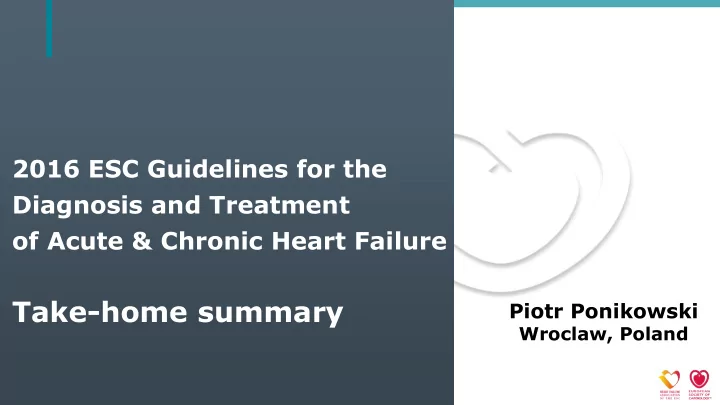

2016 ESC Guidelines for the Diagnosis and Treatment of Acute & Chronic Heart Failure Take-home summary Piotr Ponikowski Wroclaw, Poland www.escardio.org/guidelines
2 Disclosures Consultancy fees and speaker’s honoraria from: Amgen, Servier, Novartis, Johnson & Johnson, Merck, Berlin Chemie, Bayer, Cibiem, Vifor Pharma, Trevena, Abbott Vascular, Respicardia, and Cardiorentis Research support: Servier, Vifor Pharma, Singulex www.escardio.org/guidelines
Heart Failure ESC guidelines: 20 years of history www.escardio.org/guidelines
4 ESC Heart Failure Guidelines: Ten Commandments 1. Apply a novel algorithm for the diagnosis of heart failure in the non-acute setting based on clinical probability of the disease (derived from medical history, physical examination and resting ECG), the assessment of circulating natriuretic peptides and transthoracic echocardiography. www.escardio.org/guidelines
5 PATIENT WITH SUSPECTED HF (non-acute onset) ASSESSMENT OF HF PROBABILITY 1. Clinical history: History of CAD (MI, revascularization) History of arterial hypertension Exposition to cardiotoxic drug/radiation Use of diuretics Orthopnoea / paroxysmal nocturnal dyspnoea 2. Physical examination: Rales Bilateral ankle oedema Heart murmur Jugular venous dilatation Laterally displaced/broadened apical beat 3. ECG: Any abnormality www.escardio.org/guidelines
6 PATIENT WITH SUSPECTED HF (non-acute onset) ASSESSMENT OF HF PROBABILITY 1. Clinical history; 2. Physical examination; 3. ECG ≥1 present all absent Assessment of natriuretic peptides not routinely done NATRIURETIC PEPTIDES no in clinical practice • NT-proBNP ≥125 pg/mL HF unlikely: • BNP ≥35 pg/mL consider other diagnosis yes normal ECHOCARDIOGRAPHY If HF confirmed (based on all available data): determine aetiology and start appropriate treatment www.escardio.org/guidelines
7 ESC Heart Failure Guidelines: Ten Commandments 2. Use transthoracic echocardiography in patients with suspected or established HF for the assessment of myocardial structure and function along with the measurement of LVEF to establish the diagnosis of HF with reduced (HFrEF, LVEF<40%), mid-range (HFmrEF, LVEF: 40-49%) or preserved ejection fraction (HFpEF, LVEF≥50%). www.escardio.org/guidelines
8 Definition of heart failure with preserved (HFpEF), mid-range (HFmrEF) and reduced ejection fraction (HFrEF) Identifying HFmrEF as a separate group will stimulate research into underlying characteristics, pathophysiology and treatment of this population www.escardio.org/guidelines
9 ESC Heart Failure Guidelines: Ten Commandments 3. To prevent or delay onset of HF and prolong life, treatment of arterial hypertension, use of statins in patients with or at high risk of coronary artery disease, use of ACE-I in patients with asymptomatic left ventricular dysfunction and beta-blockers in those with asymptomatic left ventricular dysfunction and a history of myocardial infarction are recommended. www.escardio.org/guidelines
10 Recommendations to prevent or delay the development of overt HF or prevent death before the onset of symptoms www.escardio.org/guidelines
11 ESC Heart Failure Guidelines: Ten Commandments 4. Implement life-saving pharmacotherapy in patients with symptomatic HFrEF, containing a combination of an ACE-I (or ARB if ACE-I not tolerated), a β-blocker and a MRA. If a patient still remains symptomatic sacubitril/valsartan is recommended to replace ACE-I. Use diuretics in order to improve symptoms and exercise capacity in patients with signs and/or symptoms of congestion. www.escardio.org/guidelines
12 ESC Heart Failure Guidelines: Ten Commandments 5. Ensure an ICD implantation in HF patients who either have recovered from a ventricular arrhythmia causing haemodynamic instability or in those with symptomatic HF, LVEF ≤35% (despite at least 3 months of OMT), in order to reduce the risk of sudden death and all-cause mortality. ICD implantation is not recommended within 40 days of an MI as implantation at this time does not improve prognosis. www.escardio.org/guidelines
13 ESC Heart Failure Guidelines: Ten Commandments 6. Implant a cardiac resynchronization therapy in symptomatic patients with HF, LVEF ≤35% (despite at least 3 months of OMT), in sinus rhythm with a QRS duration ≥130 msec and LBBB QRS morphology, in order to improve symptoms and reduce morbidity and mortality. CRT is contra-indicated in patients with a QRS duration < 130 msec. www.escardio.org/guidelines
14 Therapeutic algorithm for a patient with symptomatic HFrEF www.escardio.org/guidelines
15 ESC Heart Failure Guidelines: Ten Commandments 7. In the management of a patient with suspected acute HF, try to shorten all diagnostic and therapeutic decisions. During an initial phase, reassure that circulatory or/and ventilatory support is provided in case of either cardiogenic shock or/and ventilatory failure, respectively. www.escardio.org/guidelines
16 ESC Heart Failure Guidelines: Ten Commandments 8. In parallel, identify immediately coexisting life- threatening clinical conditions and/or precipitants (according to the CHAMP acronym - acute Coronary syndrome, Hypertension emergency, Arrhythmia, acute Mechanical cause, Pulmonary embolism) and introduce a guideline-recommended specific management. www.escardio.org/guidelines
Patient with suspected AHF Urgent phase Circulatory support yes 1. Cardiogenic shock ? after first medical • pharmacological contact • mechanical no Initial Ventilatory support yes 2. Respiratory failure ? • oxygen management of • NIPPV(CPAP, BiPAP) • mechanical ventilation no a patient with Immediate phase Immediate stabilization acute HF (initial 60-120 minutes) and transfer to ICU/CCU Identification of acute aetiology: C acute C oronary syndrome H H ypertensive emergency A A rrhythmia M acute M echanical cause Immediate initiation of specific treatment P P ulmonary embolism yes no Follow detailed recommendations in the specific ESC guidelines Diagnostic work-up to confirm AHF www.escardio.org/guidelines Clinical evaluation to select optimal management
18 ESC Heart Failure Guidelines: Ten Commandments 9. During an early phase of AHF for an optimal management apply the algorithm based on clinical profiles evaluating the presence of congestion and peripheral hypoperfusion. Remember that hypoperfusion is not synonymous with hypotension, but often hypoperfusion is accompanied by hypotension. www.escardio.org/guidelines
Management of patients with acute heart failure based on clinical profile during an early phase www.escardio.org/guidelines
Management of patients with acute heart failure based on clinical profile during an early phase www.escardio.org/guidelines
21 ESC Heart Failure Guidelines: Ten Commandments 10. Enrol the patients with HF in a multidisciplinary care management program in order to reduce the risk of HF hospitalization and mortality. www.escardio.org/guidelines
22 ESC Heart Failure Guidelines: take-home summary „The best physician for a patient with HF would be one with excellent training, extensive experience, and superb judgment with regard to all aspects of the disease. He or she would not necessarily follow guidelines slavishly .” J.N. Cohn, Circ Heart Fail 2008;1:87-88 www.escardio.org/guidelines
Recommend
More recommend